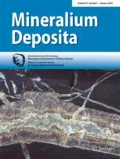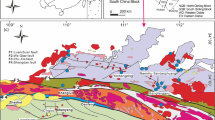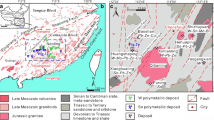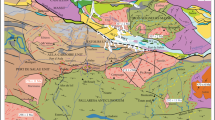Abstract
The Hämmerlein polymetallic deposit is hosted in skarn, schists, and gneisses that reached their metamorphic peak at ~ 340 Ma during the Variscan orogeny. The deposit is spatially closely associated with one of the most voluminous granites of the Erzgebirge, the Eibenstock granite which intruded the metamorphic units at ~ 320 Ma, and locally also developed greisen mineralization. Cassiterite is the main ore mineral in the Hämmerlein skarn and in greisen mineralizations associated with the Eibenstock granite. The age of skarn formation is bracketed by multi-mineral Rb-Sr isochron ages of the gneisses (~ 340 Ma) and the end of ductile deformation (> 330 Ma). The dated calc-silicate minerals of the skarn have elevated Sn contents, which implies that some Sn was present in the system during regional metamorphism, i.e., well before the emplacement of the Eibenstock granite. Tin in the > 330 Ma old skarn silicates possibly was mobilized from the metamorphic wall rocks. Retrogression of the skarn mineral assemblage may have released some Sn that formed cassiterite in an assemblage with chlorite and fluorite. The Sr isotope signatures of fluorite indicate that this late assemblage is not related to cooling of the metamorphic rocks, but to the emplacement of the Eibenstock granite, which introduced additional Sn into the skarn. Thus, mineralization in the Hämmerlein deposit includes Sn that was introduced during two different events from different sources.













Similar content being viewed by others
References
Anglo Saxony Mining (2015) Westerzgebirge project Hämmerlein-Tellerhäuser: long section through adit. http://www.anglosaxony.com/projects/germany/tellerhauser. Accessed 04 June 2018
Brady J, Perkins D (2015) Mineral formulae recalculation. SERC Carleton College http://serc.carleton.edu/research_education/equilibria/mineralformulaerecalculation.html. Accessed 31 May 2017
Breiter K (1993) The Nejdek pluton—discussion of granite evolution and Sn-W mineralization. Z Geol Wissenschaft 21:2–36
Breiter K (2012) Nearly contemporaneous evolution of the A- and S-type fractionated granites in the Krušné hory/Erzgebirge Mts., Central Europe. Lithos 151:105–121
Breiter K, Förster HJ, Seltmann R (1999) Variscan silicic magmatism and related tin-tungsten mineralization in the Erzgebirge-Slavkoský les metallogenic province. Mineral Deposita 34:505–521
Dadàk V, Novák F (1965) Tin-containing andradite from Plavno mine in the Krušné Hory Mts., Czechoslovakia. Mineral Mag 35:379–385
deCapitani C, Petrakakis K (2010) The computation of equilibrium assemblage diagrams with Theriak/Domino software. Am Mineral 95:1006–1016
de Vore GW (1955) The rate of adsorption in the fractionation and distribution of elements. J Geol 63:159–190
Diamond LW (2001) Review of the systematics of CO2-H2O fluid inclusions. Lithos 55:69–99
Förster B (1996) U/Pb Datierung an Pechblenden der U-Lagerstätte Aue-Niederschlema (Erzgebirge). Ph.D. Thesis, University of Giessen, Germany
Förster HJ (1998) Die variszischen Granite des Erzgebirge und ihre akzessorischen Minerale. Habilitation Thesis, Tech Univ Bergakademie Freiberg, Germany
Förster HJ, Romer RL (2010) Carboniferous magmatism. In: Linnemann U, Romer RL (eds) Pre-Mesozoic geology of Saxo-Thuringia—from the Cadomian active margin to the Variscan orogen, 1st edn. Schweizerbart, Stuttgart, pp 287–308
Förster HJ, Tischendorf G, Trumbull RB, Gottesmann B (1999) Late-collisional granites in the Variscan Erzgebirge, Germany. J Petrol 40:1613–1645
Franke W (1989) Tectonostratigraphic units in the Variscan belt of central Europe. Geol Soc Spec Pap 230:67–90
Glodny J, Bingen B, Austrheim H, Molina JF, Rusin A (2002) Precise eclogitization ages deduced from Rb/Sr mineral systematics: the Maksyutov complex, Southern Urals, Russia. Geochim Cosmochim Acta 66:1221–1235
Hawthorne FC, Dirlam DM (2011) Tourmaline the indicator mineral: from atomic arrangement to viking navigation. Elements 7:307–312
Heinrich W (2007) Fluid immiscibility in metamorphic rocks. Rev Mineral Geochem 65:389–430
Johan Z, Strnad L, Johan V (2012) Evolution of the Cínovec (Zinnwald) granite cupola, Czech Republic: composition of feldspars and micas, a clue to the origin of W, Sn mineralization. Can Mineral 50:1131–1148
Kempe U, Bombach K, Matukov D, Schlothauer T, Hutschenreuter J, Wolf D, Sergeev S (2004) Pb/Pb and U/Pb zircon dating of subvolcanic rhyolite as a time marker for Hercynian granite magmatism and Sn mineralization in the Eibenstock granite, Erzgebirge, Germany: considering effects of zircon alteration. Mineral Deposita 39:646–669
Kroner U, Hahn T, Romer RL, Linnemann U (2007) The Variscan orogeny in the Saxo-Thuringian zone–heterogenous overprint of Cadomian/Paleozoic Peri-Gondwana crust. Geol S Am S 423:153–172
Kroner U, Romer RL (2013) Two plates—many subduction zones: the Variscan orogeny reconsidered. Gondwana Res 24:298–329
Kroner U, Roscher M, Romer RL (2016) Ancient plate kinematics derived from the deformation pattern of continental crust: Paleo- and Neo-Tethys opening coeval with prolonged Gondwana-Laurussia convergence. Tectonophysics 681:220–233
Kröner A, Willner AP, Hegner E, Frischbutter A, Hofmann J, Bergner R (1995) Latest Precambrian (Cadomian) zircon ages, Nd isotopic systematics and P-T evolution of granitoid orthogneisses of the Erzgebirge, Saxony and Czech Republic. Geol Rundsch 84:437–456
Leake BE, Wooley AR, Arps CES, Birch WD, Gilbert MC, Grice JD, Hawthorne FC, Kato A, Kisch HJ, Krivovichev VG, Linthout K, Laird J, Mandarino JA, Maresch WV, Nickel EH, Rock NMS, Schumacher JC, Smith DC, Stephenson NCN, Ungaretti L, Whittaker EJW, Youzhi G (1997) Nomenclature of amphiboles: report of the subcommittee on amphiboles of the international mineralogical association commission on new minerals and minerals names. Can Mineral 35:219–246
Lefebvre MG, Romer RL, Glodny J, Roscher M (2017) Two stages of skarn formation in the Hämmerlein tin-skarn deposit, western Erzgebirge, Germany. 14th SGA Bienn Meet 4:1305–1308
Leonhardt D, Geißler E, Engelhardt-Sobe A, Baumgart G (2004) Geologische Karte des Freistaates Sachsen 1:25000. Blatt 5542 Johanngeorgenstadt. Sächsisches Landesamt für Umwelt und Geologie Abteilung Geologie (ed)
Leonhardt D, Geißler E, Engelhardt A, Baumgart G. (2010) Geologische Karte des Freistaates Sachsen 1:25000. Blatt 5541 Eibenstock. Sächsisches Landesamt für Umwelt und Geologie Abteilung Geologie (ed)
Leonhardt D, Geißler E, Fritzsche H (1999) Geologische Karte des Freistaates Sachsen 1:25000. Blatt 5543 Oberwiesenthal. Sächsisches Landesamt für Umwelt und Geologie Abteilung Geologie (ed)
Linnemann U, McNaughton NJ, Romer RL, Gehmlich M, Drost K, Tonk C (2004) West African provenance for Saxo-Thuringia (Bohemian Massif): did Armorica ever leave pre-Pangean Gondwana?—U/Pb-SHRIMP zircon evidence and the Nd-isotopic record. Int J Earth Sci 93:683–705
Malyshev BI, Korzhanovskaya VS (1989) Behavior of tin in calcareous-skarn and greisen processes. Geokhimiya 2:216–226
Malyshev BI, Mironova OF, Naumov VB, Savel’eva NI, Salazkin AN, Volosov AG (1997) Fluids of the Hemmerlein Skarn-Greisen tin deposit, Erzgebirge, Germany. Geokhimiya 1:179–188
Matte P (1986) Tectonics and plate tectonics model for the Variscan belt of Europe. Tectonophys 126:329–374
McIver JR, Mihálik P (1975) Stannian andradite from “Davib Ost”, South West Africa. Can Mineral 13:217–221
Mingram B (1998) The Erzgebirge, Germany, a subducted part of northern Gondwana: geochemical evidence for repetition of early Palaeozoic metasedimentary sequences in metamorphic thrust units. Geol Mag 135:785–801
Mueller AG, McNaughton NJ (2000) U-Pb ages constraining batholith emplacement, contact metamorphism, and the formation of gold and W-Mo skarns in the southern cross area, Yilgarn craton, Western Australia. Econ Geol 95:1231–1257
Mueller AG, Campbell IH, Schiøtte L, Sevigny JH, Layer PW (1996) Constraints on the age of granitoid emplacement, metamorphism, gold mineralization, and subsequent cooling of the Archean greenstone terrane at Big Bell, Western Australia. Econ Geol 91:896–915
Rojík P (2005) Tin deposits at Přebuz and Rolava in the Krušné hory/Erzgebirge, Czech Republic: classic localities, new challenges. J Czech Geol Soc 50:157–165
Romer RL, Hahne K (2010) Life of the Rheic Ocean: scrolling through the shale record. Gondwana Res 17:236–253
Rötzler K, Plessen B (2010) The Erzgebirge: a pile of ultrahigh- to low-pressure nappes of Early Paleozoic rocks and their Cadomian basement. In: Linnemann U, Romer RL (eds) Pre-Mesozoic geology of Saxo-Thuringia—from the Cadomian active margin to the Variscan Orogen. Schweizerbart, Stuttgart, pp 253–270
Rötzler K, Schumacher R, Maresch W, Willner A (1998) Characterization and geodynamic implications of contrasting metamorphic evolution in juxtaposed high-pressure units of the western Erzgebirge (Saxony, Germany). Eur J Mineral 10:261–280
Schmidt C (2018) Formation of hydrothermal tin deposits: Raman spectroscopic evidence for an important role of aqueous Sn (IV) species. Geochim Cosmochim Acta 220:499–511
Schuppan W, Hiller A (2012) Die Komplexlagerstätten Tellerhäuser und Hämmerlein. Bergbaumonografie, Freiberg Band 17:162p
Selway J, Xiong J (2015) Tourmaline recalculation: developed by Julie Selway & Jian Xiong. Andy Tindle—Free Software. http://www.open.ac.uk/earth-research/tindle/AGTWebPages/AGTSoft.html. Accessed 31 May 2017
Shapenko VV, Šmidel P (1991) Sn and W mineralization in skarn-greisen deposits at the northern margin of the Bohemian massif. Geokhimiya 5:724–732
Štemprok M, Blecha V (2015) Variscan Sn-W-Mo metallogeny in the gravity picture of the Krušné hory/Erzgebirge granite batholith (Central Europe). Ore Geol Rev 69:285–300
Sukhoruchkin SI, Soroko ZN (2009a) Atomic mass and nuclear binding energy for Fe-56 (Iron). In: Schopper H (ed) Landolt-Börnstein—group I elementary particules, nuclei and atoms. Springer, Berlin Heidelberg, pp 2276–2278
Sukhoruchkin SI, Soroko ZN (2009b) Atomic mass and nuclear binding energy for Sn-119 (tin). In: Schopper H (ed) Landolt-Börnstein—group I elementary particules, nuclei and atoms. Springer, Berlin Heidelberg, pp 6838–6840
Tichomirowa M, Hofmann M, Schaltegger U, Sergeev S, von Quadt A, Whitehouse M (2016) The “older” and “younger” granites from the western Erzgebirge—comparison of different zircon dating methods. Freib Online Geosci 46:36–38
Tichomirowa M, Leonhardt D (2010) New age determinations (Pb/Pb zircon evaporation, Rb/Sr) on the granites from Aue-Schwarzenberg and Eibenstock, western Erzgebirge, Germany. Z Geol Wiss 38:99–123
Tischendorf G, Gottesmann B, Förster H-J, Trumbull RB (1997) On Li-bearing micas: estimating Li from electron microprobe analyses and an improved diagram for graphical representation. Mineral Mag 61(409):809–834
Tischendorf G, Förster HJ, Gottesmann B (2001) Minor and trace-element composition of trioctahedral micas: a review. Mineral Mag 65:249–276
Velichkin VI, Chernyshov IV, Simonova LI, Yudintsev SV (1994) Geotectonic position, petrochemical and geochronological features of the Younger Granite Complex in the Krŭsné Hory (Erzgebirge) of the Bohemian massif. J Czech Geol Soc 39:116
Wang L, Shimazaki H, Wang J, Wang Y (2001) Ore-forming fluid and metallization of the Huanggangliang skarn Fe-Sn deposit, Inner Mongolia. Sci China Ser D 44:735–747
Wang RC, Xie L, Chen J, Yu A, Wang LB, Lu JJ, Jinchu Zhu JC (2013) Tin-carrier minerals in metaluminous granites of the western Nanling Range (southern China): constraints on processes of tin mineralization in oxidized granites. J Asian Earth Sci 74:361–372
Wenzel T, Mertz DF, Oberhänsli R, Becker T, Renne PR (1997) Age, geodynamic setting, and mantle enrichment processes of a K-rich intrusion from the Meissen massif (northern Bohemian massif) and implications for related occurrences from the mid-European Hercynian. Geol Rundsch 86:556–570
Werner O, Lippolt HJ (2000) White mica 40Ar/39Ar ages of Erzgebirge metamorphic rocks simulating the chronological results by a model of Variscan crustal imbrication. In: Franke W, Haak V, Oncken O, Tanner D (eds) Orogenic processes: quantification and modelling in the Variscan belt of Central Europe. Geol Soc Lond Spec Publ 179:323–336
Willner A, Rötzler K, Maresch W (1997) Pressure-temperature and fluid evolution of quartzo-feldspathic rocks with a relic high-pressure, granulite-facies history from the central Erzgebirge (Saxony, Germany). J Petrol 38:307–336
Zhao KD, Jiang SY, Jiang YH, Wang RC (2005) Mineral chemistry of the Qitianling granitoid and the Furong tin ore deposit in Hunan Province, South China: implication for the genesis of granite and related tin mineralization. Eur J Mineral 17:635–648
Acknowledgments
We thank Saxore Bergbau GmbH for providing access to the outcrops and samples. We thank Bettina Hübner for her support during the chemical preparation of the samples, and Franziska Wilke and Oona Appelt for their help during EPMA analysis.
Funding
This project was supported by the German Government BMBF grant 033R134A awarded to RLR.
Author information
Authors and Affiliations
Corresponding author
Additional information
Editorial handling: R. Linnen
Rights and permissions
About this article
Cite this article
Lefebvre, M.G., Romer, R.L., Glodny, J. et al. The Hämmerlein skarn-hosted polymetallic deposit and the Eibenstock granite associated greisen, western Erzgebirge, Germany: two phases of mineralization—two Sn sources. Miner Deposita 54, 193–216 (2019). https://doi.org/10.1007/s00126-018-0830-4
Received:
Accepted:
Published:
Issue Date:
DOI: https://doi.org/10.1007/s00126-018-0830-4




